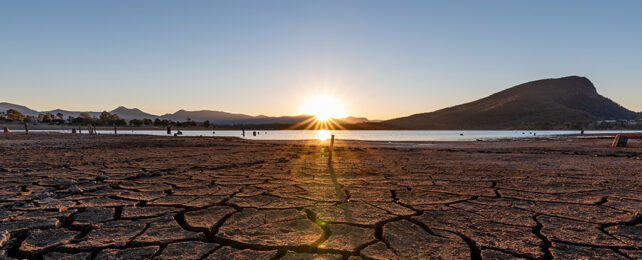Droughts can have dramatic effects in Australia – decimating agriculture, threatening water resources and devastating the environment. Much of Australia is drought-prone, and the risk is expected to increase as global warming continues.
That's why it's important for Australia to be prepared for droughts, particularly those lasting multiple years.
To have some idea of just how bad things might get, we must look far back in time to see what's come before. That's where our new research comes in.
We examined computer simulations of Earth's climate over the past 1,150 years. Worryingly, we found that given enough time, natural variability in Australian rainfall can produce "mega-droughts" lasting 20 years or more. If we add in human-caused climate change, it suggests future droughts will be far worse than we imagined.
Rainfall records aren't enough
To understand the full picture of future droughts, we need historical rainfall data. But in Australia these records only go back to around the year 1900. This doesn't fully record the huge range of natural rainfall variability over many hundreds of years.
To a degree, we can get these long records from features of the environment such as trees, which record information about rainfall changes in their annual growth rings. Unfortunately, these natural "archives" generally only reach back a few hundred years. And they only store information about what's happened in their local area, not across all of Australia.
Scientists need alternative ways of looking back in time – and that's what our new research set out to do.
We used computer models of Earth's climate from the years 850 to 2000 (1,150 years in total) to fill in the picture. The models simulate the interactions of the atmosphere, oceans, ice and land, and so provide a picture of how the climate has changed through time.
Because no single climate model is perfect, we used an "ensemble" of 11 different climate models to explore the range of droughts Australia has experienced.
First, we looked at the characteristics of Australian droughts due to natural fluctuations in rainfall. Then we compared the simulated droughts during the 20th century with those from the pre-industrial period (before the year 1850). This let us test if human-caused climate change during the past century has caused detectable changes in Australian droughts.
We paid particular attention to the Murray-Darling Basin in south-eastern Australia. It contains Australia's largest river system and is our largest agricultural region, so it's important to know how bad droughts there could be.
Our results
We found during the 20th century, simulated droughts in southwestern and eastern Australia – including the Murray-Darling Basin – were longer on average compared with pre-industrial times.
This change is consistent with the rainfall trends expected in these regions in future due to human-caused climate change. It suggests that an emerging human influence on our climate has already made southern parts of Australia more drought-prone.
Other characteristics of simulated Australian droughts, such as their intensity or recurrence, didn't show marked differences last century compared to pre-industrial times. In other words, human-caused climate change had probably not yet caused Australian droughts to be any drier, or changed how often we are in drought. But this influence could still emerge as climate change worsens.
The devastating impacts of Australia's last major drought from 2017 to 2019, known as the "Tinderbox" drought, are a stark reminder of what we might expect in future. The drought was likely worsened by human-caused climate change, and preceded the catastrophic Black Summer fires.
How bad could Australian droughts be?
One of the most concerning findings from our research is that even without the effects of climate change, natural variability can produce "mega-droughts" in Australia lasting 20 years or more. That is far longer than any drought that has been experienced in Australia since instrumental records began.
Our findings show mega-droughts are possible across the Australian continent. This includes the Murray-Darling Basin where typical droughts last century lasted four to five years. The graphic below shows the worst of these since direct rainfall records began. A 20-year drought would make these extremes seem short-lived.
Mega-droughts are possible in Australia
This new research shows mega-droughts in Australia are possible – even without the influence of climate change. They are a natural part of Australian rainfall variability over the long term. This finding is supported by evidence drawn from ice cores, which suggests a 39-year drought gripped eastern Australia around 800 years ago.
This is concerning, because climate change is also increasing the chance of reduced rainfall across much of southern Australia.
It's difficult to imagine a drought lasting several decades. But our research suggests it can happen, and future droughts in Australia will be worse than any in our recent historical experience.
Our work highlights the need to consider the unthinkable when it comes to preparing for future droughts. This has implications for industry, governments and communities as they adapt to a warmer future.![]()
Georgina Falster, Postdoctoral Fellow, Australian National University; Nerilie Abram, Chief Investigator for the ARC Centre of Excellence for Climate Extremes; Deputy Director for the Australian Centre for Excellence in Antarctic Science; Deputy Director for the Centre of Excellence for 21st Century Weather, Australian National University, and Nicky Wright, Research Fellow, University of Sydney
This article is republished from The Conversation under a Creative Commons license. Read the original article.
